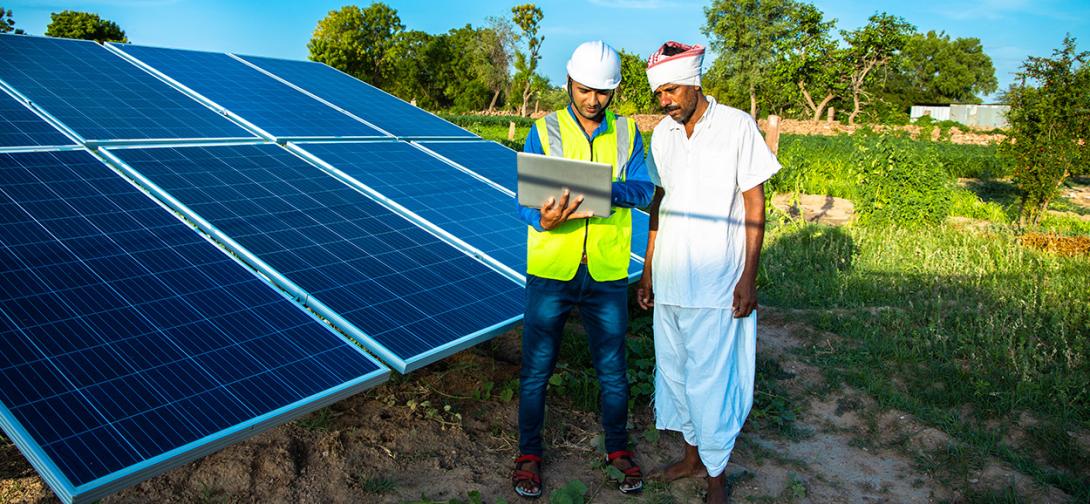A Green India for all: An aspiration
As India’s green energy sector prepares to leap forward, it is worth examining the landscape and charting out the path ahead. Reforms in this sector have been on-going for over a decade and the total installed capacity from renewable sources has doubled in the last five years, touching the 100 GW mark this August. While this is surely a noteworthy improvement, India continues to depend on oil and gas imports. So, on this Independence Day, in alignment with SDG Goal 7 – “Ensure access to affordable, reliable, sustainable and modern energy for all”, the Prime Minister took a pledge to make India energy-independent by 2047. This requires challenging the status quo of policy implementation and starting with the grassroots, instead of highly developed regions.
The Prime Minister also recognised a need for ‘Sabka Prayas’, i.e., participation from the industry and from local governments and communities. Local communities are brimming with the potential for transformation. Launched under the umbrella of ‘Sabka Saath, Sabka Vikas’, the Aspirational Districts Programme focuses on participation of all in the nation’s economy. For a country as socioeconomically diverse as India, it is very difficult to have an all-sharing growth model without proper policy interventions that can reach the grassroots. These interventions assist in creating strong systems which prioritize subnational contexts and needs, and measure the long-term progress towards sustainable development using the unique delta ranking system.
There are 112 Aspirational Districts across the country. UNDP’s appraisal shows that these districts have made more progress than non-aspirational districts. From model anganwadis to the digital tracking of child-growth charts, malnutrition through Poshan App, the program has been instrumental in engineering development through data to monitor improvements in 6 key areas. The programme’s unique feature relies on measuring the long-term progress in delta change instead of absolute values.
The UNDP also highlights the use of green technology for basic infrastructure development in Aspirational Districts. It showcases Goalpara, Assam, which used recycled plastic and geogrid technology to construct 183 km of green road. In fact, it is the first district in India to construct a green road. This has led to a large delta improvement with the establishment of over 400 habitations in the district with access to all-weather roads. As the nation moves ahead in its journey of a greener tomorrow, the most backward have the greatest advantage and can achieve maximum delta change.
Under the Aspirational District Programme, Basic Infrastructure also includes electricity.
Conventional electricity grids are difficult to extend to remote areas, and hence alternative solutions can be found in green energy technology. To make the most of India’s green energy potential for its Aspirational Districts, two complementary interventions are imagined. The first is to boost the manufacture of green energy technology through Production-Linked Incentives. This will generate supply, increase exports of world-class green energy products, and create employment. The second is to install and commission small-scale green energy capacity across the Aspirational Districts. Its usage by the community will improve the quality of life, vitalize the local economy, and generate demand. All of this together will generate a cycle of socioeconomic growth.
For green energy implementation, Gumla, an aspirational district in Jharkhand, has already taken the first inspiring step. The installation of home based solar panels has enabled access to clean energy and reduced dependence on unreliable conventional energy. This has led the village out of darkness.
On the basis of the maturity and feasibility of green energy technologies, the interventions should begin with solar energy. The advantage with solar energy lies in India's geography and the innovative solar cells. Solar farms can be set up even in small sizes. This increases availability and reduces transmission costs. Despite these advantages, the uptake of solar energy has been slow.
This is because the old silicon-based technology used in solar cells had to be imported and had an efficiency below 15%, making it too expensive to have small solar farms. However, recent technological and policy developments have revolutionized this landscape. First, the new perovskite-based technology has an efficiency of nearly 30% and costs only one-tenth of the old technology, and hence is economically viable at smaller scales. Second, the policy of AatmaNirbhar Bharat has encouraged production of solar cell technology within India, leading to lower costs and product reliability. Gumla and Goalpara are only examples of the many districts which are leveraging and harnessing the local resources and participating in bringing about a positive social change. The transformational journey to a greener future needs such inclusive mass movements. The Aspirational District Programme is the best initiative to channel such a transformation by leveraging local communities, as it removes heterogeneities in regional variations in development.
The programme with its increased scope in energy transitions, will power India’s ambitions as a world leader in green energy and achieve Agenda 2030. It serves as a lighthouse not just for our green energy revolution but also provides a model that is replicable across the world. With the motto of leaving no one behind and progressing by taking along those who are at the most risk of falling behind, our aspirational districts have proven their successes and have come out with flying colours as Champions of Change.
Views expressed above are the author's own.
Juhi Jain, Young Professional, AIM, NITI Aayog and Siddhey Shinde, Young Professional, S&T, NITI Aayog
This article was originally published in The Economic Times.
 National Portal Of India
National Portal Of India 


